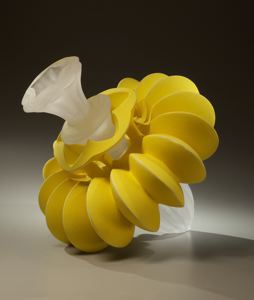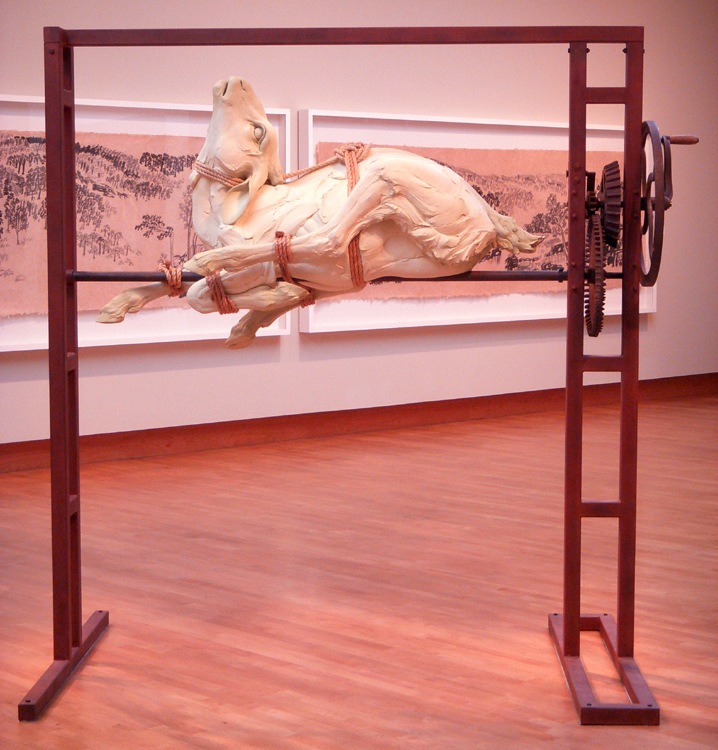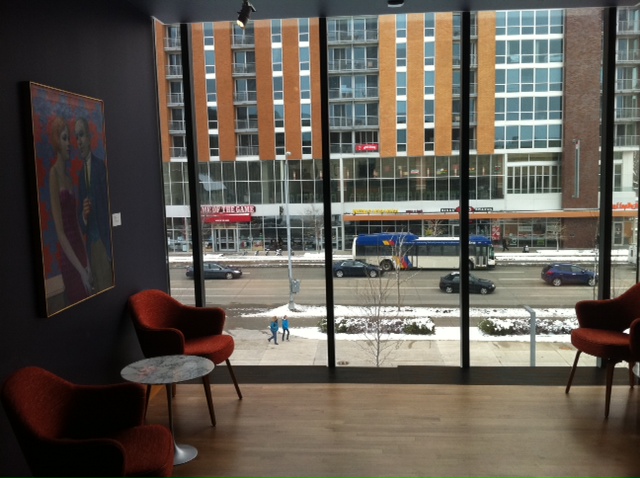
Etsuko Tashima. "Cornucopia 09-Y3," 2010. Slip-covered stoneware and cast glass 20 1/2 x 19 3/4 x 17 3/4 inches. Courtesy the Chazen Museum of Art.
Before last week I couldn’t tell you the last time I was at an art museum where the guards outnumbered the spectators. Last Thursday I had virtual free reign of the Chazen Museum at the University of Wisconsin, Madison for three hours and it was blissful. While I was there I think there was a 1:1 guest to David Smith sculpture ratio at the height of the crowd.
After viewing a faculty exhibition I went upstairs and collapsed on a stuffed leather bench before I started to fixate on a Japanese ceramic vase that looked like a creature living in a deep ocean vent. Perched in front of a window overlooking the bustling UW campus and close to comfortable furniture – the kind of viewing experience I don’t get in New York City. In its setting, the piece, by Japanese artist Tashima Etsuko, was a license for mind wandering–the art equivalent of trippy light show at a Jefferson Airplane concert. I slouched against the wall and slipped into a daydream about uncanny morphologies starring Hans Bellmer, Ken Price and Eve Hesse. Rarely have I indulged in such flights of free association at the MoMA or the New Museum, which is a shame, because they possess a lot of great art with which to free-associate.
The privacy made me wonder how social my museum experiences have become. Sometimes I think of New York as the pot of water and frogs that rises to a boil so gradually that the frogs never notice enough to save themselves. At its most ebullient, New York museums are filled with hundreds of frogs simmering in stimuli, unaware of the desensitizing effects. I often go to museums with friends and colleagues, conducting conversations at the same time as I look at art. Sure the talk is art-related, but commentary isn’t the same as direct and sustained engagement. And even when I’m solo, there are always too many circulating bodies, ambient conversations and crackling headsets to upset any chance of metaphysical transportation. I even know people who go to museums in New York specifically to watch people watch art. Is that art or anthropology?
I had a spasm about the thought of art voyeurism passing as art appreciation before moving on and into a large open gallery with a multi-paneled piece by Nicola López called Concentration City and a stunning sculpture by Beth Cavener Stichter, Humiliation by Design, that jerked me back into reality. López’s densely packed, slightly forlorn urban landscape contrasts powerfully with Stichter’s aching and tragically personal image of a goat bound to an industrial spit. My differing reactions testify not only to art’s breadth, but also to the value of unexpected relationships in museums between unrelated objects. It made me consider Berthold Brecht’s practice of “estrangement,” where content is intended to prevent passive disengagement with the work. Is a curator’s job to promote deep reflection or to force an abrupt interaction? Should the viewer seek complete absorption or active intervention? Where’s Michael Fried when you need him?

Beth Cavener Stichter. "Humiliation by Design," 2009. Stoneware, acrylic paint, steel, cast iron gears, rope 82 x 83 x 52 inches. Courtesy the Chazen Museum of Art.
The rest of the Chazen’s 20th century galleries continued to offer gifts of art and serenity. A large, washy abstract painting recognizable as a Helen Frankenthaler introduced a series of smaller post-painterly abstract pieces by Paul Jenkins, an artist with whom I was less familiar. I ordered his monograph on Amazon that evening and am now converted. I wondered if I would have picked out Jenkins from the din and roil of the Museum of Modern Art on a Saturday, if he even made it to the wall – they probably have dozens of them sitting in storage in Long Island City.

Paul Jenkins. "Phenomena Mesmer Wakes," 1969-1970. Acrylic on canvas 51 x 48 inches. Courtesy the Chazen Museum of Art
Trying to find the exit I doubled back through a hallway filled mostly with mid-century abstract sculpture by David Smith, Seymour Lipton, Anthony Caro, et al. Smaller sculptures were interspersed with works on paper, a nice curatorial touch. Harsh winter light from a large window highlighted the jagged angles of some David Smiths. A little sitting area was set up in front of it. To continue with the relaxed theme of the day, I sat and watched students go to class and counted people entering and exiting a chain restaurant across the street. The strangest Mark di Suvero tabletop sculpture lurked over my right shoulder. Then it hit me: the last time I felt so easy in a museum was also next to, or rather, under, a Mark di Suvero…at Storm King sculpture park. Never mind that it is on 500 acres of land in the middle of the Catskills. That was also the only time I’ve ever had a picnic lunch while leaning against a piece of museum-quality art.
Last Thursday was a memorable and necessary reprieve from the madding art crowd, without sacrificing actual art. And it was also the first time I’ve ever been within eyeshot of a Mark di Suvero and Andy Warhol and a Buffalo Wild Wings at the same time. Somehow that strange juxtaposition was an apt punctuation mark on the day.




